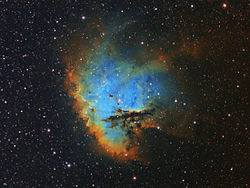NGC 281 from Chandra
The optical data (seen in red, orange, and yellow) show a small open cluster of stars, large lanes of obscuring gas and dust, and dense knots where stars may still be forming. The X-ray data (purple), based on a Chandra observation lasting more than a day, shows a different view. More than 300 individual X-ray sources are seen, most of them associated with IC 1590, the central cluster. The edge-on aspect of NGC 281 allows scientists to study the effects of powerful X-rays on the gas in the region, the raw material for star formation.
A second group of X-ray sources is seen on either side of a dense molecular cloud, known as NGC 281 West, a cool cloud of dust grains and gas, much of which is in the form of molecules. The bulk of the sources around the molecular cloud are coincident with emission from polycyclic aromatic hydrocarbons, a family of organic molecules containing carbon and hydrogen. There also appears to be cool diffuse gas associated with IC 1590 that extends toward NGC 281 West. The X-ray spectrum of this region shows that the gas is a few million degrees and contains significant amounts of magnesium, sulfur and silicon. The presence of these elements suggests that supernova recently went off in that area.Relevante Bilder
Relevante Artikel
NGC 281NGC 281 ist ein Emissionsnebel im Sternbild Kassiopeia am Nordsternhimmel, der 9500 Lichtjahre von der Erde entfernt ist. Der Nebel ist im Index-Katalog als IC 11 erfasst und wird umgangssprachlich wegen seiner Ähnlichkeit mit der bekannten gleichnamigen Videospiel-Hauptfigur vor allem im englischen Sprachraum auch als Pac-Man-Nebel bezeichnet. In NGC 281 ist der offene Sternhaufen IC 1590 eingebettet, dessen Sterne um das Zentrum des Nebels verstreut sind und von denen einige durch ihre Röntgenstrahlung hervortreten. Das hellste Mitglied von IC 1590, das Mehrfachsternsystem BD +55° 191 (HD 5005), ist die ionisierende Quelle des Nebels. Der Nebel enthält auch mehrere Bok-Globulen, in denen durch Infrarotaufnahmen Anzeichen für Sternentstehung festgestellt werden konnten. Ebenfalls in Infrarotaufnahmen ist die Molekülwolke erkennbar, deren ionisierter Teil der Emissionsnebel ist. .. weiterlesen



